
views
Setting up Your Concrete

Purchase concrete slabs as thick as 6 inches (15 cm). For thicker slabs, which are between 4 to 6 inches (10 to 15 cm), expect to pay about 1 USD more per square foot. And if you have your slab delivered by your supplier and the truck cannot reach the delivery space, you might have to pay for a pump truck at an additional cost. Buy concrete from home hardware stores or local independent concrete suppliers.

Mark off the region to be cut with a piece of chalk. For small slabs of concrete, use a piece of chalk to mark of the region that you need to cut. Either freehand the line or place a set square onto your slab and mark along the straight edge with your chalk. Stick with blue and white chalk—other colors are better suited for projects that take longer than 1 week. If you're cutting a square or rectangle, make sure the straight edge makes a 90-degree angle with the side of the granite so your cut is more precise.
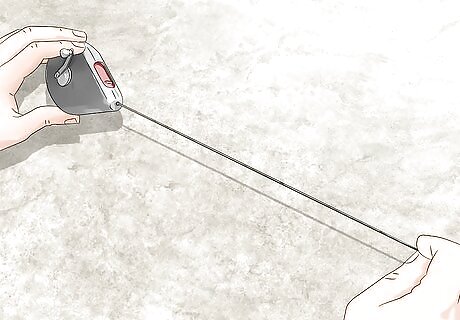
Designate the area of finished concrete to be cut using chalk lines. When you're cutting concrete that is already poured and finished, use a chalk line to mark the region. Get a friend to hold one end while you hold the other and run the line over the region to be cut. Lift the line simultaneously from each end and slap it to the ground. Alternatively, you can freehand a line using a piece of chalk—just be sure to make it as thick as possible. Purchase chalk lines from home hardware stores. This simple tool is a reel of string that is coated with chalk and can be used to mark long, straight lines more accurately than free-handing. Use blue and white chalk if you want the lines to last about 1 week. For longer projects, use orange, yellow, or green for a 2 or 3-week lifespan, and red or black for a 2-month lifespan.
Using a Circular Saw
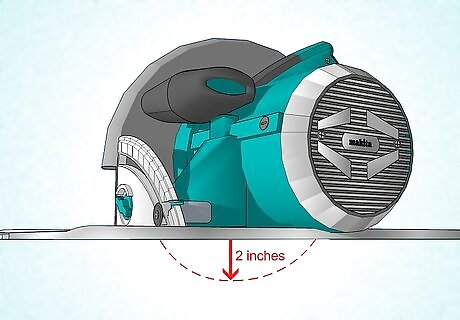
Set the blade depth of your circular saw to 2 inches (5.1 cm). Release the blade lever and move the base plate that surrounds the saw until 2 inches (5.1 cm) of the saw is exposed. Once the blade is the right depth, tuck your finger under the shoe with your index finger to hold it steady and tighten the blade lever. Always unplug the circular saw before adjusting blade depth. If you're having trouble setting the right depth, find a long piece of wood 2 inches (5.1 cm) thick and use it as a guide.
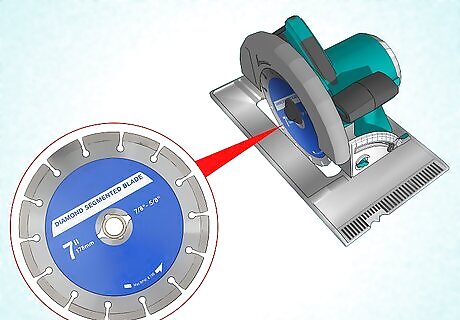
Attach a 7 inch (18 cm) diamond blade to a 15-amp circular saw. Attach a pair of vice grips to the edge of the old blade so that it can't move. Use a wrench to remove the center bolt holding the blade in place. Afterward, remove the small rim (also known as the flange) underneath it and take out the old blade. Attach a diamond blade so that the teeth point in the opposite direction of movement. Reattach the flange and retighten the bolt. If the diamond blade is moving around while you're screwing it on, attach vice grips to it. Use dry-cutting diamond blades if you're making a series of cuts that increase in depth. Invest in wet-cutting diamond blades if you want to make fast, clean cuts and you have a compatible saw. Do not over tighten the blade-locking nut. Diamond blades are strong enough to cut through tough materials like concrete, brick, and granite.
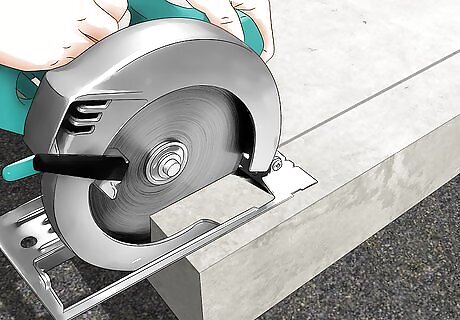
Saw along the lines with the circular saw. Get on your hands and knees and face the chalk line at a 45-degree angle. Grip the front-most handle of the blade with your dominant hand and use it to guide the saw. Use your dominant hand to grip the back handle and push the blade forward and backward. Begin cutting at the edge of the concrete and slowly follow the chalk line. Don't press the blade into the ground—let the weight of the blade and saw do the work. Remove the blade every 30 to 45 seconds to avoid overheating. If you're not using a wet-cutting diamond blade and the saw is gas powered, pour water onto your blade as you cut to reduce dust and blade temperature. A garden hose that is set very low is perfect for this. Always wear eye protection when using a circular saw.
Using a Cut-Off Saw

Mark the cutlines on your concrete using chalk lines or a piece of chalk. For perfectly straight lines, use a chalk line. Gran one end yourself and have a friend hold the other. Hold the line about 2 feet (0.61 m) over the region to be cut. In one quick motion, raise the chalk line up about 1 foot (0.30 m) and snap it down so that it hits the ground and applies chalk in a straight line. If you freehand your line with chalk, make sure to make it as thick as possible. For a 1-week chalk lifespan, use blue and white colors. Orange, green, and yellow last 2 to 3 weeks, while red and black last around 2 months.

Attach a 14 inch (36 cm) wet-cutting diamond blade to a cut-off saw. Fix a pair of vice grips to the side of the old blade to prevent it from spinning. Unscrew the center bolt in the middle of the blade with a wrench. Now, remove the small rim piece (called a flange) underneath and take the old blade out. Attach your diamond blade, taking care that the teeth point in the opposite direction as the cut. Finally, reattach the flange and bolt. Fix a pair of vice grips to the diamond blade if it's moving around while you're reattaching the bolt. A diamond blade will be strong enough to cut through concrete. You can also use it to cut through brick and granite.
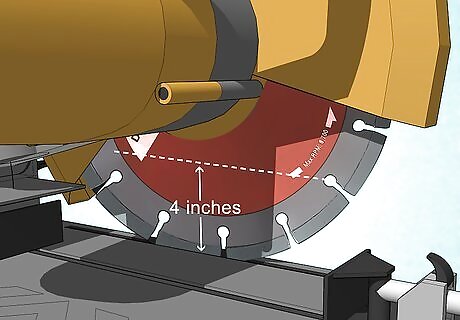
Adjust the blade depth of your cut-off saw. If you're using a cut-off saw, you're probably cutting concrete between 4 to 6 inches (10 to 15 cm) in depth. Loosen the blade lever to release it and adjust the base plate around the saw until the correct amount of saw is exposed. After the blade is at the right depth, place your index finger under the base plate to hold it in place and tighten the blade lever. To help you accurately adjust the depth, place the saw onto a long piece of wood as thick as the desired depth. Let the blade hang down over one side and use it as a guide.

Cut along the chalklines at the lowest revolutions per minute (RPM) setting. Angle the saw at a 45 degrees to the concrete and stand slightly to the left of the saw so that you're also facing the cutline at a 45-degree angle. Hold the backmost handle with your dominant hand and use it to move the saw forward and backward. Grip the frontmost handle with your non-dominant hand and use it to guide the blade along the chalk line. Proceed slowly, maintaining minimum RPMs of the cut-off saw. Face your dominant foot outward from the saw, perpendicular to the cutline. Keep your nondominant foot facing the cutline at a 45-degree angle. Cut for 30 to 45 seconds at a time and let the blade cool for an equal amount of time. Never apply water to electric cut-off saw blades.



















Comments
0 comment